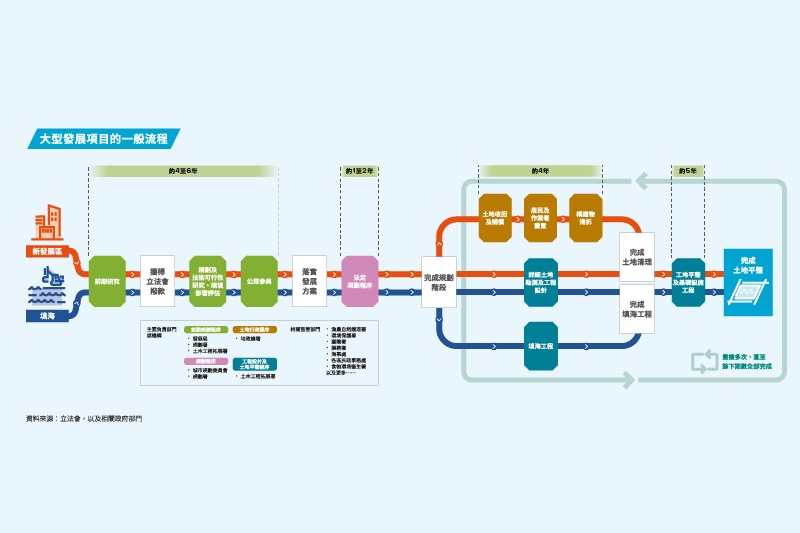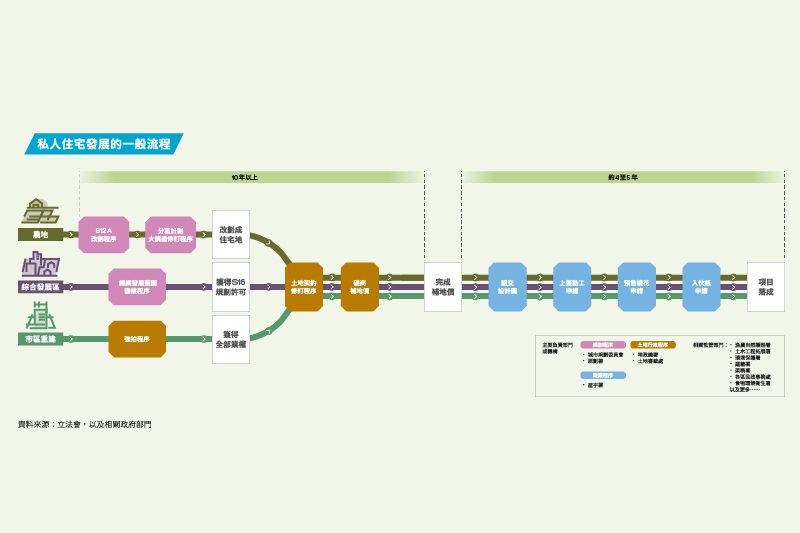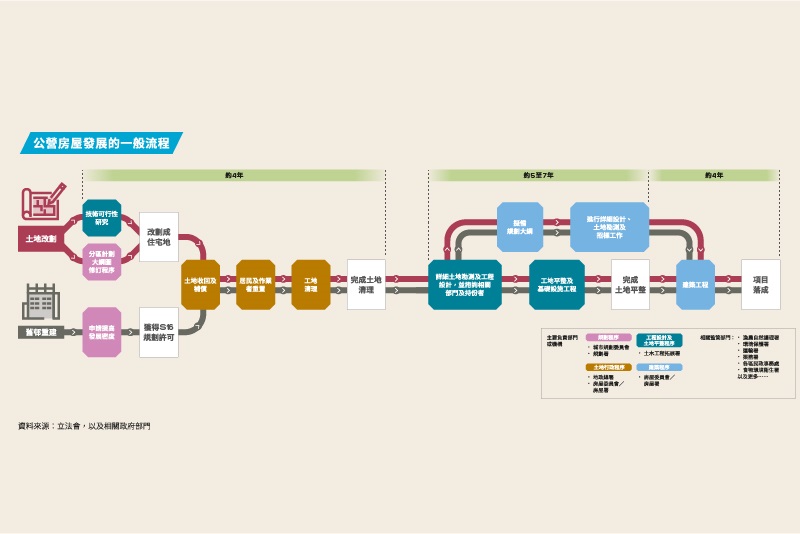OHKF Calls for Three Ups to Solve Hong Kong’s Housing Woes
OHKF Calls for Three Ups to Solve Hong Kong’s Housing Woes
(24 January 2022, Hong Kong) Our Hong Kong Foundation (OHKF) releases its latest land and housing research report that urges the HKSAR Government to resolve Hong Kong’s housing supply shortage immediately by addressing the pain points at three levels: cumbersome development procedures, inefficient policy implementation, and conflicting social opinions.
A “three-up” strategy to break through the barriers is advocated: Speed Up, Efficiency Up, and Mass Up. Entitled Immediate Actions to Resolve Hong Kong's Housing Conundrum: Cut the Red Tape Now!, the Report puts forward 23 detailed recommendations with the goals of expediting housing supply in the short run, and reducing public housing waiting time.
Shortening Public Housing Waiting Time by Catching Up Shortfall of 120,000 Units
The OHKF research report published last April predicted that only about 180,000 public and private housing units will be completed between 2021 and 2025, which is insufficient to fill the past supply gap and meet future demand. Since the Long Term Housing Strategy was first proposed in 2013, the number of completions each year had failed to meet the Government’s target, with a cumulative shortfall of 120,000 public and private housing units. To fill the supply gap, a total of 300,000 units are needed, or an average of 60,000 units per year.
Comparing Hong Kong’s housing crisis to a water shortage problem, rather than digging a new well, which means developing non-spade-ready sites without infrastructures from scratch, a more feasible solution is to dig the existing well faster and deeper. Specifically, the last report estimates that about 230,000 public and private housing units will be completed between 2026 and 2030. We call on the Government to expedite the completion of 120,000 units ahead of schedule by 2025 through cutting red tape and streamlining the development process. This aggressive target is necessary to resuscitate the strangled housing supply.
This is a doable goal; whether it can be attained successfully depends on the Government’s political will. Assuming that the target is fulfilled, we estimate that the average waiting time for public rental housing general applicants will drop significantly from the current 5.9 years to 3.7 years.
Although our society has sharply divided views on many issues, we have one broad consensus: that land and housing development process must be streamlined to increase housing supply. But the key is to have a goal-oriented and whole-process strategy and holistic approach for implementation. The Report consolidates the suggestions of various parties and makes all-round recommendations on the development approval process, inter-departmental coordination, civil service efficiency, industry manpower, and industry development. In addition, to speed up the completion of 120,000 units in the short run, apart from upstream planning and public consultation, midstream and downstream stages including land resumption and clearance, engineering studies, detailed design, site formation, and infrastructure works are key processes. The Report proposes targeted recommendations that cover the entire upstream, midstream, and downstream stages of land and housing development.
Speed Up: Removing Barriers and Reorganising Workflow
The current land and housing development procedures are burdened by various obstacles linked to repetitive consultations, duplicate regulations, and inconsistent or unclear approval standards, which resulted in lengthy housing development periods. The Government must take decisive measures to reduce unnecessary or repetitive public consultations and supervision, and strengthen inter-departmental coordination. The Report presents different recommendations related to the development process of “large-scale development projects”, “private housing projects” and “public housing projects”.
(1) Large-Scale Development Projects
For large-scale development projects such as reclamation and New Development Areas (NDAs), it generally takes 14 years or more from preliminary planning to completion of the first batch of spade-ready sites.
The OHKF recommends that during the preliminary planning stage, the Government should simplify and consolidate public engagement under various ordinances, and reduce the time for Environmental Impact Assessment investigation and report production (Recommendation 1). On the other hand, in order to resume and clear land earlier, the Government should adopt different mechanisms to accelerate land assembly (Recommendation 3), and make corresponding arrangements according to the specific needs of occupiers including brownfield operators, farmers, and squatters.
Moreover, the development of NDAs is usually divided into different phases by the Government. The detailed design and land resumption of the later phrases start only after the completion of the previous phase. We advocate the Government commencing the detailed designs, land resumption, and site formation works of each phase in parallel (Recommendation 4). Also, the land exchange procedures for private lands in the remaining phases should be initiated at phase 1, in order to advance development projects (Recommendation 5).
In addition, for reclamation projects, we propose that the Government proceed with reclamation works and town planning procedure simultaneously, instead of preparing the Outline Zoning Plan (OZP) for superstructure development first before commencing reclamation (Recommendation 2).
(2) Private Housing Projects
Apart from the large-scale development projects put forward by the Government, other private residential projects mainly come from rezoning of agricultural land, Comprehensive Development Areas (CDAs), and redevelopment of aged buildings, which often take more than 10 years.
At the planning stage, we recommend the Government streamline the town planning process (Recommendation 7), e.g. shorten the statutory time for plan-making process, or allow the development to commence the subsequent procedures after obtaining the S12A planning permission, instead of waiting for the completion of the OZP amendment.
At the land administration stage, we propose to simplify land leases (Recommendation 9) and exclude specific requisites in the land leases if they are already regulated by relevant ordinances. To expedite the lease modification procedure (Recommendation 10), the Government should establish a clear timeframe for reviewing and approving lease modifications, and consider extending the use of “standard rate” to all lease modification applications for agricultural lands in the New Territories.
In particular, for CDAs, the OHKF suggests the Government should divide the CDAs into smaller sites by size and ownership distribution, and establish precise and quantifiable approval criteria for Master Layout Plans (Recommendation 6). In addition, for redevelopment of old buildings, the Government can introduce measures to accelerate the pace of redevelopment by the private sector and the Urban Renewal Authority (Recommendation 8), including lowering the threshold for compulsory sale, exploring transfer of plot ratio, and adopting a more flexible compensation strategy.
Lastly, as private residential development involves a number of bureau and departments, we also propose that the Government should strengthen the functions of the Development Project Facilitation Office (Recommendation 11) to coordinate land development approval works and balance the requirements from different departments to expedite the approval process.
(3) Public Housing Projects
Outside the boundaries of large-scale development projects, the Government develops public housing mainly through rezoning and redevelopment of aged estates, which often takes more than 10 years from preliminary planning to completion.
In terms of housing supply, apart from public consultation at the preliminary planning stage, the Government will also consult the District Councils at the subsequent detailed design stage. However, the District Councils often have various requirements on development projects, which cause repeated modifications to the design and even the projects to stagnate. Therefore, we propose that relevant departments should make professional judgments to take on board views and balance the interests of various parties to proceed swiftly to the next phase (Recommendation 12).
In addition, the Government can draw reference from the practice of the past “Private Sector Participation Scheme” to improve construction efficiency by bringing in contractors to undertake design and construction of public housing in a bundle (Recommendation 13).
We advocate the Government establishing a “one-stop” platform to disclose the progress of various public housing projects, including relevant land development procedures, submission of building plans, commencement, and completion of construction works, so as to enhance transparency and accountability of public housing projects (Recommendation 14).
Efficiency Up: Motivating Civil Service Performance
On top of removing barriers to expedite development process, the Government should activate the optimal performance of civil servants by enhancing high-level steering and accountability mechanism, developing corresponding quantifiable performance indicators for relevant departments, and launching a performance-based reward and punishment system.
The current scattering of large-scale land development work among different departments, without a dedicated coordinating department, has led to a fragmented development process. Therefore, we recommend the Government to establish a dedicated department for regional development (Recommendation 15) and set up a project office for each NDA and major land development project. Moreover, we propose the Planning Department, Lands Department, Civil Engineering and Development Department, Buildings Department, Housing Department, and other key departments involved in land and housing development should establish their own quantifiable performance indicators (Recommendation 16).
In addition, the Government should actively explore the implementation of a performance-based appraisal system (Recommendation 17) to motivate civil servants to improve their performance. In Singapore and South Korea, for example, the civil service appraisal system uses different approaches such as “relative ranking”, “rating limits”, and “expected potential rating” to identify the best and brightest in the team and offer “performance bonuses”.
Mass Up: Recognising the Social Reality and Prioritising Housing Supply
While Hong Kong is facing an unprecedented housing crisis, our society is still highly fragmented by the various rigid individual beliefs on the ideal development model. The Government must lead the community to recognise the real demand and explore all the options that can substantially increase land and housing supply.
At present, the maximum permissible development density of the New Territories is significantly lower than that of Hong Kong Island and Kowloon. Therefore, we believe that the Government must abandon the "Central perspective" and propose to re-examine and redesign the plot ratio in the appropriate Hong Kong-Shenzhen border areas, so as to increase the development density of the New Territories (Recommendation 18). We also recommend that the Government actively build up land reserve to meet long-term demands, and draw reference from the “white zone” planning tool in Singapore to allow greater flexibility in land use (Recommendation 21).
According to the Planning Department, 67% of the land in Hong Kong is green land, which is remarkably high compared with 38% in London and 8% in Singapore. We advocate the Government to review the ecological value of green land in Hong Kong and the reasonable proportion of green land in Hong Kong as soon as possible (Recommendation 19). Moreover, currently much of the 1,000 hectares of the “Wetland Buffer Area” has lost their original ecological functions. Therefore, we suggest the Government to expeditiously review the planning for the Wetland Buffer Area (Recommendation 20), taking into account the need to balance conservation and development.
Finally, Hong Kong’s construction work expenditure is expected to increase significantly in the future, but local training cannot provide sufficient skilled personnel within a short period of time. Therefore, we advocate the Government to relax the criteria for importing professionals under the Supplementary Labour Scheme, and to popularise the large-scale applications of MiC and BIM, to increase the overall construction capacity in the long run (Recommendation 22). Also, we call on the Government to facilitate robust development of the industry by moderating the scale of regulation, encouraging “professional self-inspection”, and studying new tendering models that encourage healthy competition in the market (Recommendation 23).
Dr Stephen Wong, OHKF Senior Vice President and Executive Director of Public Policy Institute, remarked: “OHKF has proposed a full range of recommendations on removing barriers to expedite each development stage of housing supply. The Government should take on a goal-oriented approach and proactively study which proposals work most efficiently to help boost housing supply in the short run. We call on the Government to implement those proposals swiftly in order to solve the deep-seated housing woes for citizens and reduce the waiting time for public housing.”
Ryan Ip, Head of Land and Housing Research of OHKF, pointed out: “Apart from filling the past supply gap in the short term, the Government should make continued efforts to push forward long-term land development plans such as the Northern Metropolis and the Lantau Tomorrow Vision, so as to avoid the projects being shelved in the endless process of repetitive study and consultations.”
Full Report of Immediate Actions to Resolve Hong Kong's Housing Conundrum: Cut the Red Tape Now!
Chinese version: https://bit.ly/32mJhRQ
English version: https://bit.ly/3rVzvyX
Full live press conference:https://youtu.be/N66jd2xpP04?t=268
_0.jpg)
_0.jpg)
_1.jpg)
Annex
Table 1: Three Major Strategies and 23 Detailed Recommendations







